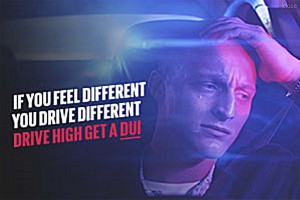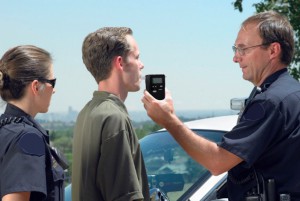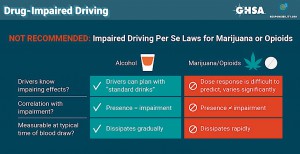
NHTSA's new ad campaign will run through Labor Day, usually one of the most deadly weekends to drive.
“Drive High, Get a DUI.”
That’s the theme of a new ad campaign being launched today by the National Highway Traffic Safety Administration that reflects growing concern about the potential risks raised by the expanding legalization of marijuana and the rise in opioid addition.
As TheDetroitBureau.com previously reportedly, tests indicate 44% of the drivers killed in U.S. car crashes in 2016 had the residue of drugs in their system – up from 28% a decade ago. Some data point to a rising death toll related to the growing, legal availability of marijuana, though not all research backs that up. Opioid use is also catching some of the blame.
Whatever drug one uses, “If you feel different, you drive different,” Heidi King the deputy administrator of the National Highway Traffic Safety Administration, said during an event in Nashville. “That’s the message we have for anyone using alcohol, marijuana or other drugs, whether obtained legally or illegally.”
NHTSA will back that message with a national ad campaign that launches today and runs through Sept. 3, the Labor Day weekend generally considered one of the deadliest times to be on the road.
(Drug use linked to growing number of fatal car crashes. Click Here for the story.)
How the new campaign will fare is far from certain, though safety advocates are hoping it will prove as effective as the push to reduce drunk driving. At the peak, during the 1960s and 1970s, intoxicated drivers caught blame for as much as half of all U.S. highway fatalities.

There is a movement underway to lower the legal blood-alcohol content limit for drunk driving to 0.05.
There has been some evidence that DUIs are on the rise again and advocates and law enforcement officials say they are particularly concerned that many motorists are combining alcohol with other drugs.
Of those who tested positive for drugs in the latest study reported by the Governors Highway Safety Association in May, 38% had used marijuana, 16% had used some form of opioid, and 4% tested positive for a combination of both. Those figures may understate the potential problem, according to the GHSA, because the majority of drivers killed in crashes don’t undergo drug tests.
“It’s impossible to understand the full scope of the drugged driving problem,” said Jim Hedlund, the author of that report and a former NHTSA official. But he stressed that, “Drugs can impair, and drug-impaired drivers can crash.”
(Click Here to see more about revival of “Click it or Ticket.”)
On the other hand, the study also raised a caution flag that reports of drugged driving may be exaggerated. Just as it is considered safe and legal to drink a modest amount of alcohol before driving, Hedlund stressed that, “Drivers who are drug-positive may not necessarily be impaired.” And it is unclear how often the use of drugs actually contributed to fatal crashes.
One of the big problems is finding a way to properly – and accurately – enforce laws that restrict driving while under the influence of any mind-altering substance, whether alcohol, marijuana or other drugs. Pot, in particular, raises challenges because, unlike alcohol, THC, the active ingredient in cannabis, remains in the blood for an extended period, typically well after a user is no longer high.
“Many studies, using a variety of methods, have attempted to estimate the risk of driving after use of marijuana,” a NHTSA report advised Congress last year. “While useful in identifying how marijuana affects the performance of driving tasks, experimental and observational studies do not lend themselves to predicting real-world crash risk.”
Indeed, several studies conducted since the first states began legalizing recreational use of marijuana have generated conflicting results. One, by the University of Colorado, and released in 2014, showed a surge in fatalities involving stoned drivers. But a NHTSA study conducted in Virginia a year later found no clear increase in risk.
(Government panel wants to lower the drunk driving threshold. Click Here for the story.)
Nonetheless, authorities want to ensure that drug driving doesn’t replace alcohol intoxication as a major source of highway crashes, injuries and fatalities.

